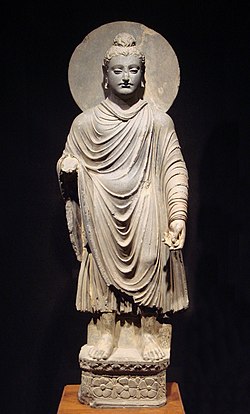In Buddhism, the three marks of existence are three characteristics (Pali: tilakkhaṇa; Sanskrit: त्रिलक्षण trilakṣaṇa) of all existence and beings, namely...
18 KB (1,822 words) - 17:24, 16 May 2025
exception, is "transient, evanescent, inconstant". Anicca is one of the three marks of existence—the other two are dukkha (suffering or unsatisfactory) and...
9 KB (887 words) - 23:30, 5 December 2024
Buddhism (redirect from Three levels of suffering)
doctrines of dependent origination, karma, and the three marks of existence. Other commonly observed elements include the Triple Gem, the taking of monastic...
251 KB (27,573 words) - 08:05, 16 May 2025
Buddhist philosophy is called the "three marks of existence", which are aniccā (impermanence), anattā (absence of a permanent self), and dukkha (suffering)...
130 KB (13,415 words) - 05:36, 28 May 2025
Philosophical pessimism (redirect from Philosophy of pessimism)
Together, these three marks of existence illustrate a fundamentally negative view of life from the Buddhist perspective. Since one of the central concepts...
120 KB (13,663 words) - 04:09, 5 June 2025
Four Noble Truths (redirect from Noble Truths of Buddhism)
arya satya") are "the truths of the noble one (the Buddha)," a statement of how things really are (the three marks of existence) when they are seen correctly...
159 KB (19,492 words) - 00:30, 2 May 2025
Duḥkha (redirect from Pain of pain)
dukkha is part of the first of the Four Noble Truths and one of the three marks of existence. The term also appears in scriptures of Hinduism, such as...
34 KB (3,455 words) - 10:05, 1 April 2025
Wabi-sabi (category Japanese style of gardening)
teaching of the three marks of existence (三法印, sanbōin), which include impermanence (無常, mujō), suffering (苦, ku), and emptiness or absence of self-nature...
23 KB (2,484 words) - 08:27, 25 May 2025
Vipassana movement (category Schools of Buddhism founded in Myanmar)
the practice of satipatthana to acquire Vipassana (insight) into the three marks of existence as the main means to attain the beginning of awakening and...
41 KB (4,822 words) - 09:19, 25 May 2025
Theravada (redirect from Way of the elders)
goal of the practice is to achieve mundane and supramundane wisdom. Mundane wisdom is the insight in the three marks of existence. The development of this...
147 KB (17,342 words) - 08:19, 30 May 2025
Bardo Thodol (redirect from Tibetan book of the dead)
mean ‘between.’ The Sanskrit bhava means a place of existence. Thus antarābhava means ‘an existence between,’ translated into Tibetan as bardo. thos grol:...
26 KB (3,045 words) - 19:12, 20 May 2025
Third eye (redirect from Three Eyed)
Awareness of existence Erlang Shen – Deity in the Chinese pantheon Eye of Horus – Ancient Egyptian symbol of protection, royal power and good health Eye of Providence –...
9 KB (1,026 words) - 12:35, 27 April 2025
nature of reality", which is defined as anicca ("impermanence"), dukkha ("suffering, unsatisfactoriness"), and anattā ("non-self"): the three marks of existence...
95 KB (9,459 words) - 15:47, 24 May 2025
Impermanence (category Concepts in ancient Greek philosophy of mind)
philosophy it is notable for its role in the Buddhist three marks of existence. It is also an important element of Hinduism. In Western philosophy it is most famously...
14 KB (1,535 words) - 08:30, 9 February 2025
a number of earlier Buddhist schools accepting the existence of such an intermediate state, while other schools rejected it. The concept of antarābhava...
26 KB (2,928 words) - 22:07, 13 May 2025
Dharmamudrā (section Types of Dharmamudrā)
all phenomena (a related term is the three marks of existence), but is generally interpreted as the "seal" or "mark" that distinguish the Buddhist teachings...
3 KB (322 words) - 09:21, 2 March 2025
Medawi (category Scholars of Buddhism)
be said that the religion of practice has gone extinct. Medawi's meditation manual focuses on the three marks of existence and the five aggregates, and...
3 KB (331 words) - 05:52, 1 November 2024
Enlightenment in Buddhism (category Pages displaying short descriptions of redirect targets via Module:Annotated link)
vipassana, insight into the three marks of existence, namely anicca, dukkha and anatta. Insight leads to the four stages of enlightenment and Nirvana....
40 KB (4,497 words) - 09:42, 28 May 2025
Nagarjuna (category Articles with Internet Encyclopedia of Philosophy links)
Aristocles Passage resemble the Buddhist three marks of existence. According to him, the key innovative tenets of Pyrrho's scepticism were only found in...
46 KB (5,383 words) - 11:32, 5 June 2025
Bhavacakra (redirect from Wheel of existence)
wheel of life is a visual teaching aid and meditation tool symbolically representing saṃsāra (or cyclic existence). It is found on the walls of Tibetan...
27 KB (3,278 words) - 15:48, 8 February 2025
Ātman (Buddhism) (category Conceptions of self)
Samyutta Nikaya Self (spirituality) Shunyata Soul Srimala Sutra Three marks of existence Buddha-dhatu, mind, Tathagatagarbha, Dharma-dhatu, suchness (tathata)...
30 KB (3,555 words) - 14:02, 6 May 2025
Buddhist cosmology (redirect from 31 planes of existence)
(Kamadhātu). The three realms contain together thirty-one planes of existence, each corresponding to a different type of mentality. These three realms (tridhātu...
79 KB (10,558 words) - 19:54, 21 April 2025
existence, which is connected to anatta (no-self), the third of the three marks of existence. According to the 14th Dalai Lama, Phenomena are merely imputed...
2 KB (197 words) - 21:39, 17 January 2025
realms a being enters into. Three marks of existence: everything, whether physical or mental, is impermanent (anicca), a source of suffering (dukkha), and...
97 KB (10,028 words) - 17:08, 14 April 2025
Saṃsāra (section Etymology and terminology of Samsara)
"cycle of aimless drifting, wandering or mundane existence". When related to the theory of karma, it is the cycle of death and rebirth. The "cyclicity of all...
57 KB (6,236 words) - 01:48, 19 March 2025
Mono no aware (redirect from Ah-ness of life)
one of the three marks of existence in buddhism, representing impermanence. Awareness of the transience of all things heightens appreciation of their...
11 KB (1,157 words) - 16:12, 24 May 2025
poisons are said to be the root of all of the other kleshas. The three poisons are represented in the hub of the wheel of life as a pig, a bird, and a snake...
9 KB (856 words) - 19:42, 25 May 2025
Pratītyasamutpāda (redirect from Twelvefold chain of dependent origination)
for the arising of unwholesome samskaras (like craving). Likewise, skillful perceptions (such as focusing on the three marks of existence) lead to wholesome...
180 KB (20,198 words) - 20:25, 26 May 2025
the Three Jewels and Three Roots are supports in which a Buddhist takes refuge by means of a prayer or recitation at the beginning of the day or of a practice...
15 KB (1,840 words) - 14:51, 7 February 2025
Buddhahood (redirect from Three types of buddha)
proper rendering support, you may see question marks or boxes, misplaced vowels or missing conjuncts instead of Indic text. In Buddhism, Buddha (/ˈbuːdə, ˈbʊdə/...
85 KB (8,762 words) - 09:39, 28 May 2025




















